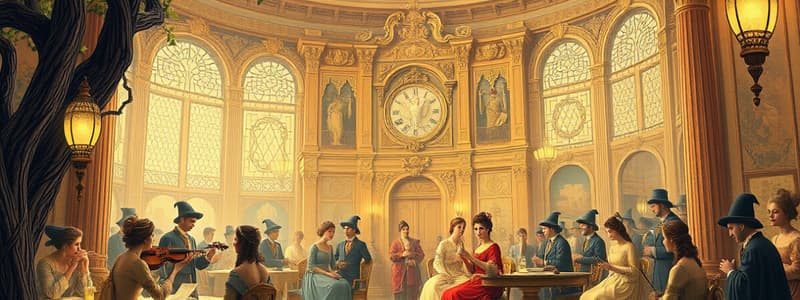Podcast
Questions and Answers
What years define the Classical Period?
What years define the Classical Period?
1750-1820
Which of the following were major events during the Classical Period? (Select all that apply)
Which of the following were major events during the Classical Period? (Select all that apply)
- Seven Years War (1756-1763) (correct)
- Louis XVI France (1774-1792) (correct)
- French Revolution (correct)
- American Declaration of Independence (correct)
What scientific advances occurred during the Classical Era?
What scientific advances occurred during the Classical Era?
Changed the world's view, faith in power of reason, undermining traditional authority, and social organization.
Who were the three main composers of the Classical Period?
Who were the three main composers of the Classical Period?
The Classical Style transitioned to the period between 1730 and 1770.
The Classical Style transitioned to the period between 1730 and 1770.
What characterizes a Classical Symphony?
What characterizes a Classical Symphony?
What is a Coda in music?
What is a Coda in music?
What is the Sonata Form?
What is the Sonata Form?
What are the components of a Classical Concerto?
What are the components of a Classical Concerto?
What renowned works did Joseph Haydn produce?
What renowned works did Joseph Haydn produce?
What distinguished the music of Mozart?
What distinguished the music of Mozart?
What were some characteristics of Beethoven's music?
What were some characteristics of Beethoven's music?
Flashcards are hidden until you start studying
Study Notes
Classical Period
- Lasted from 1750 to 1820, marking significant cultural and artistic advancements.
Major Events in the Classical Period
- Seven Years War occurred from 1756 to 1763.
- Louis XVI reigned in France from 1774 to 1792.
- American Declaration of Independence happened in 1776.
- The French Revolution began in 1789.
- Napoleon I established the French Empire starting in 1804.
- The Napoleonic Wars spanned from 1803 to 1815.
- "Pride and Prejudice" by Jane Austen was published in 1813.
Classical Era Influences
- Scientific advancements shifted global perspectives, enhancing faith in reason and questioning traditional authorities.
- The Age of Enlightenment fostered the rise of a middle class.
- Art moved away from the ornate Baroque style to simpler forms.
Classical Style
- Transition period occurred from 1730 to 1770.
- Pioneering composers included C.P.E. Bach and J.C. Bach.
- Musical and visual arts emphasized balance and structure.
Prominent Composers
- Joseph Haydn, renowned for his symphonic works.
- Wolfgang Amadeus Mozart, a prolific composer noted for his operas and chamber music.
- Ludwig van Beethoven, known for bridging Classical and Romantic styles.
Characteristics of Classical Music
- Mood contrasts emphasized within and between movements.
- Rhythmic flexibility allowed for multiple patterns in a single piece.
- Primarily homophonic texture emphasized clear melodic lines.
- Melodies were tuneful, often influenced by folk music.
- Dynamics highlighted emotional expression through gradual changes.
- Marked the decline of basso continuo, a prevalent accompaniment style.
Classical Orchestra
- Instrumentation became standardized with increased size compared to previous periods.
- Composers utilized diverse timbres, allowing for varied melodic exchanges between instruments.
Classical Forms
- Instrumental works typically consisted of multiple movements, often structured in four parts: fast, slow, dance-related, and fast.
- Key ensembles included symphonies, string quartets, and sonatas.
Music Capital of Europe
- Vienna emerged as the primary musical center during this period.
Sonata Form
- Known as Sonata-Allegro Form, prevalent structure in Classical music extending into the 20th century.
Sonata Ternary Structure
- Features three sections (ABA):
- Exposition (A): introduces first and second themes.
- Development (B): builds tension through thematic fragmentation.
- Recapitulation (A): resolves tension by restating themes.
Coda
- A distinct ending section often labeled as a "tail."
Theme and Variations
- Simple form lacking a contrasting "B" section, with a basic idea repeated and varied.
Minuet and Trio
- Based on a formal court dance with a ternary structure (Minuet-Trio-Minuet).
Rondo Form
- Revolves around a recurring main theme interspersed with contrasting sections, structured commonly as ABACA or ABACABA.
Sonata-Rondo
- Combines elements of both sonata and rondo forms.
Classical Symphony
- A substantial multi-movement work lasting 20 to 45 minutes.
- Typically structured into four movements: fast, slow, dance (minuet or scherzo), and fast.
Classical Concerto
- A composition featuring a soloist and orchestra often structured in three movements: fast, slow, fast, with the first movement typically in sonata form.
Classical Chamber Music
- Designed for intimate settings, with small ensembles (four to nine instruments), often featuring one player per part.
String Quartet
- Comprises two violins, a viola, and a cello structured into four movements.
Joseph Haydn
- Austrian composer active during the early to mid-Classical period.
- Recognized for talent at a young age, served the Esterházy family for 30 years.
- Composed 104 symphonies and 68 string quartets, known for polyphonic style and folk influences.
Wolfgang Amadeus Mozart
- Austrian composer of the middle classical period and a child prodigy.
- Transitioned to freelance musician status in Vienna at age 25, gaining the favor of the emperor.
- Composed in various forms, leaving behind operas that focused on relatable characters.
Mozart's Composition Style
- Masterpieces included a wide range of forms, with works that seem effortless and were composed rapidly.
Ludwig van Beethoven
- German composer representing the late classical period, known for his profound impact on music.
- Experienced a challenging childhood with a strict musical upbringing.
- Successfully transitioned into freelance work, composing seminal works even after becoming deaf.
- Created both Classical and Romantic compositions, famously experimenting with dynamics and form.
Studying That Suits You
Use AI to generate personalized quizzes and flashcards to suit your learning preferences.




